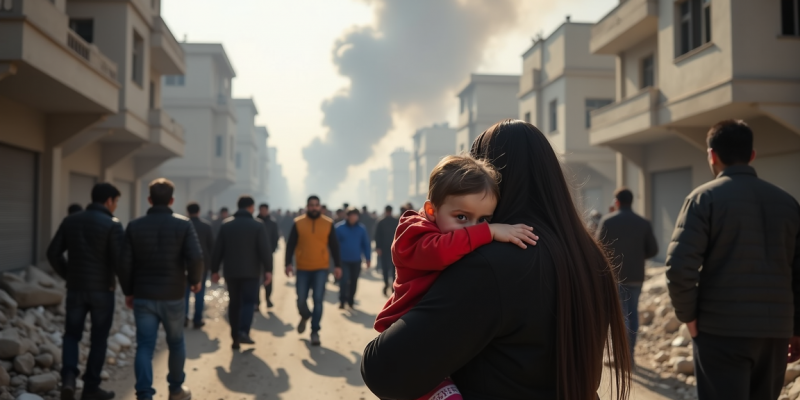
The long-simmering, complex conflict between Israel and Iran, a defining feature of the Middle East for decades, has violently erupted into a new and perilous phase.
Previously characterized by indirect attacks and proxy engagements, the hostilities have dramatically escalated, culminating in Israel’s reported airstrikes on Iranian military targets and its nuclear program on June 13.
This audacious move, which included the targeting of scientists and generals and reportedly killed the head of the Islamic Revolutionary Guard Corps, Hossein Salami, has pushed the two regional powers dangerously close to open warfare.
For years, Israel and Iran engaged in a shadow war, a series of mostly quiet, often deniable attacks, with Iran frequently operating through allied proxy groups.
However, this fragile equilibrium began to unravel following the outbreak of war between Israel and the Iran-backed Palestinian group Hamas in October 2023.
Since then, isolated incidents of direct fire, utilizing missiles and drones, have punctuated the escalating tensions.
The June 13 Israeli airstrikes, which caused explosions in the Iranian capital, Tehran, represent a major escalation.
In response to its own “pre-emptive strike,” Israel declared a state of emergency, bracing for the anticipated retaliation that Iranian officials have warned would follow any attack on its assets.
With a renewed global focus on Iran’s nuclear capabilities, the specter of open warfare looms large.
Israel, widely believed to possess its own nuclear arsenal, has long viewed a nuclear-armed Iran as an existential threat.
A friendship shattered: the roots of enmity
The current animosity starkly contrasts with a period of alliance between Israel and Iran that began in the 1950s under Iran’s last monarch, Shah Mohammad Reza Pahlavi.
This friendship abruptly ended with the 1979 Islamic Revolution in Iran.
The new clerical leadership in Tehran adopted a fiercely anti-Israel stance, calling for its destruction and denouncing the Jewish state as an imperialist power in the Middle East.
Since then, Iran has consistently supported groups that actively fight Israel, most notably Hamas, Hezbollah in Lebanon, and the Houthi rebels in Yemen—all designated as terrorist organizations by the United States.
For Israel, the prospect of Iran obtaining nuclear weapons is an overriding security concern.
Israeli officials have repeatedly implied that if Iran were on the verge of weapons capability, Israel would take pre-emptive military action, much as it did when it struck a reactor in Iraq in 1981 and an alleged Syrian nuclear site in 2007.
A history of direct confrontation
Prior to the latest Israeli offensive, the two nations had already exchanged direct blows for the first time in April 2024.
Iran launched a massive missile and drone attack on Israel, a move precipitated by an airstrike two weeks earlier on Iran’s diplomatic buildings in Damascus, Syria—an attack widely attributed to, though not officially acknowledged by, Israel.
While Iran’s April assault caused minimal damage and prompted a more limited Israeli counter-assault, this direct head-to-head fighting marked a dangerous precedent, moving their conflict into a more overt and perilous phase.
Further escalating the direct conflict, Israel assassinated Hamas’s political leader, Ismail Haniyeh, in Tehran in July of the same year.
Another round of missile attacks and airstrikes was exchanged by both sides in October.
Military might: a tale of asymmetry and ambition
In a conventional military comparison, Israel’s forces possess a significant technological advantage over Iran’s.
This is partly due to substantial military and financial support from the United States, which has long sought to ensure Israel’s qualitative military edge.
Israel is the only Middle Eastern state to have acquired Lockheed Martin Corp.’s F-35 stealth fighter jet, the world’s costliest weapons system.
It is also widely, though unofficially, understood to be a nuclear-armed state.
Iran, conversely, has long been suspected of harboring ambitions to develop nuclear weapons under the guise of its civilian nuclear power program—an ambition it consistently denies.
The country’s reserves of highly enriched uranium have been growing and could, according to experts, be quickly purified to the 90% level typically used in nuclear weapons if its leadership chose to do so.
However, Iran would still need to master the complex process of weaponizing the fuel to produce an operable device capable of hitting a remote target.
Decades of sanctions and political isolation have hampered Iran’s access to foreign military technology, compelling it to develop its own indigenous weapons capabilities.
Its combat aircraft fleet largely consists of older models acquired before the 1979 revolution.
Iran hopes to upgrade its military through increased collaboration with Russia, having agreed to purchase Sukhoi Su-35 fighter jets, although the delivery status of these aircraft remains unclear.
Despite its technological disadvantages, Iran’s military is believed to possess a significant stockpile of ballistic and cruise missiles, as well as a large fleet of relatively inexpensive unmanned aerial vehicles (drones), which it deployed against Israel in its 2024 assaults.
However, as those attacks demonstrated, penetrating Israel’s formidable, multi-layered air defenses is a significant challenge.
Israeli defenses include advanced fighter jets, the Arrow and David’s Sling air-defense systems, which, in conjunction with US and other allied forces in the region, reportedly intercepted 99% of the more than 300 drones and missiles Iran fired in the April 2024 barrage, according to Israel’s military.
Iran’s own defensive capabilities include surface-to-air missile systems, such as Russia’s S-300, and the locally made Arman anti-ballistic missile system.
These systems are not nearly as battle-tested as Israel’s, a reflection of Iran’s preference for asymmetric warfare, where it can project outsized power, over direct conventional combat. Both nations also possess cyberwarfare capabilities.
Over a decade ago, the Stuxnet malware, widely suspected to be a US and Israeli operation, compromised operations at an Iranian nuclear enrichment facility.
According to a US Defense Intelligence Agency assessment released last year, Iran is capable of “a range of cyber operations, from information operations to destructive attacks against government and commercial networks worldwide.”
Past cyberattacks attributed to Iran include a hack targeting Israeli water infrastructure, as noted by the Council on Foreign Relations.
The challenge of striking Iran’s nuclear program
An Israeli air attack specifically targeting Iran’s nuclear program would be an extreme and logistically complex operation.
Iran’s atomic sites are numerous, geographically dispersed, and, in recent years, many key assets have been moved deep underground to protect them from attack.
This has not deterred smaller-scale sabotage operations routinely attributed to Israel, including the assassinations of five Iranian nuclear scientists in Tehran since 2010 and an explosion at a key enrichment facility in 2021, for which Iran blamed Israel.
Israel claims to have destroyed most of Iran’s air defenses and much of its missile-making capacity in the October 2024 exchange.
If these capabilities have indeed been significantly neutralized, Israel would face considerably less resistance in a solo attack.
However, intelligence officials have cautioned that even a successful strike on Iran’s nuclear facilities might only delay, not definitively destroy, the country’s ability to eventually manufacture an atomic weapon.
Moreover, any such attack would be complicated by the operational requirements for Israel’s most advanced fighter jets, which would likely need aerial refueling to strike targets in Iran and return safely.
A senior Iranian military official responsible for protecting the country’s nuclear program stated in April 2024 that Iran would retaliate in kind if Israel targeted its assets.
He also hinted that even the threat of such an attack could push Iran to reconsider its stated policy of a peaceful nuclear program.
A web of alliances: regional and global alignments
Iran’s most crucial allies are the Shiite militias it supports with funding, weapons, and training in Lebanon (Hezbollah), Yemen (Houthis), and Iraq.
Hezbollah had long been the most formidable of these, but its recent clashes with Israel since the start of the Gaza war, including an Israeli ground incursion into Lebanon, have reportedly left it seriously weakened.
Tehran also lost its only state ally in the Middle East, Syria, with the fall of President Bashar al-Assad in December 2024.
Yemen’s Houthi rebels would likely be eager to participate in any wider conflict between Israel and Iran.
Since the start of the Israel-Hamas war, the Houthis have been launching ballistic missiles and drones at Israel, in addition to attacking commercial shipping in the Red Sea.
A Houthi drone strike in central Tel Aviv in July 2024 resulted in a fatality, the first deadly attack of its kind on Israeli soil. In early May 2025, a Houthi missile struck near Israel’s main airport, leading numerous foreign airlines to suspend flights.
Iran also maintains warm relations with Russia, although Russia’s ongoing war in Ukraine would likely limit its capacity to provide substantial assistance in a new conflict.
The Islamic Republic also has good ties with China, which has continued to purchase Iranian oil despite US and allied sanctions.
Israel, on its part, counts the United States and the United Kingdom as its key allies. Forces from both countries assisted in intercepting some of the missiles and drones Iran launched at Israel in 2024.
The US military also announced measures to bolster its presence in the Middle East, deploying additional ships, fighter planes, and ballistic missile defense vessels.
Nevertheless, the Israeli operation poses the first major foreign-policy crisis of US President Donald Trump’s second term, particularly as he had reportedly urged Israeli Prime Minister Benjamin Netanyahu not to proceed with such a strike.
The Arab states: a precarious balancing act
Many Arab states in the region find themselves in a difficult position.
Four Gulf Arab countries normalized relations with Israel in 2020 through the Abraham Accords, partly driven by a shared distrust of Iran.
However, these same countries have also sought to mend ties with Tehran as they focus on domestic economic growth and navigate a perceived US disengagement from the region.
Unlike during previous periods of tension over Iran’s nuclear program, this time they are publicly backing diplomatic solutions.
Iran and Saudi Arabia restored diplomatic relations in 2023 after a seven-year freeze.
Saudi Arabia has previously explored normalizing ties with Israel as part of a broader deal involving US security guarantees and would likely try to avoid becoming entangled in an Israel-Iran conflict.
It is considered unlikely that any Arab state would overtly side with Israel in a direct confrontation against a fellow Muslim country, especially one as powerful as Iran.
That said, an Israeli strike on Iran might only require their tacit acquiescence for Israeli jets to transit through their airspace.
The unfolding situation presents a complex geopolitical chessboard with potentially far-reaching consequences.
The post Israel’s attack on Iran deepens old conflict: what does this mean for the Middle East? appeared first on Invezz










